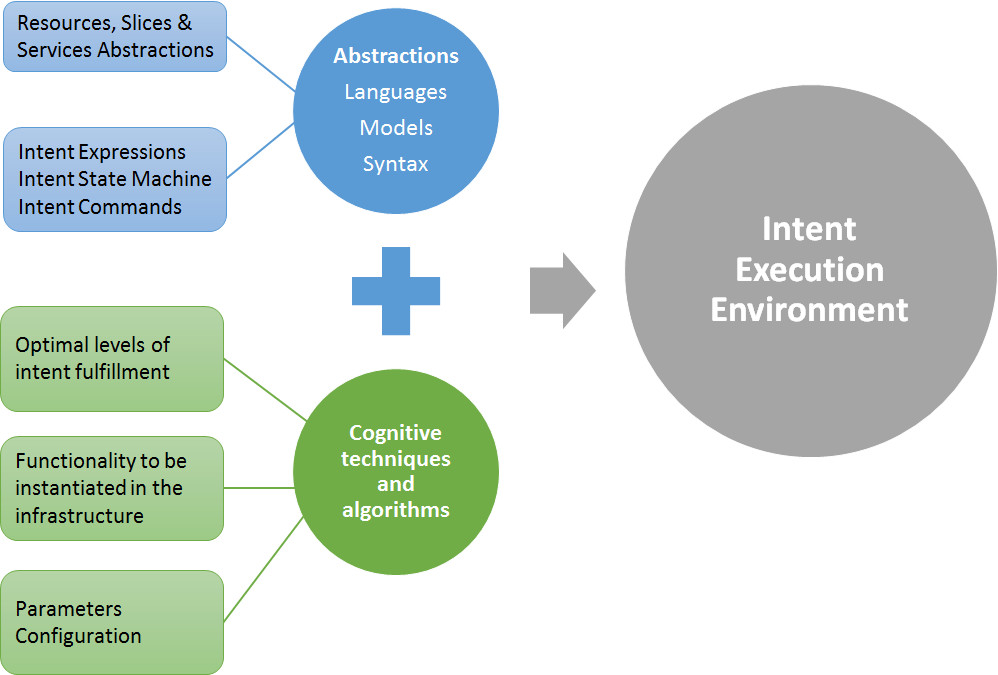Addressing Key Challenges in 5G Networks with “Intent-Driven Networking”
Eleni Giannopoulou, WINGS ICT Solutions, Athens, Greece; Panagiotis Demestichas, Vera Stavroulaki, University of Piraeus, Dpt of Digital Systems, School of ICT, Piraeus, Greece; Imen Grida Ben Yahia, Orange Labs, Paris, France; and Laurent Ciavaglia, Nokia Bell Labs, Paris, France
Introduction
As 5G networks are expected to scale to unprecedented levels due to the increasing traffic demand and data production rate, there is a need for managing in a unified way the heterogeneity of the 5G infrastructure while at the same time supporting the introduction of new services and the management of new slices on demand. Other highly challenging aspects in today’s networks operation are the reduction of the time to deploy new services and the optimization of CAPEX/OPEX ratio.
This article presents a novel management approach based on the concept of Intent-Based Networking (IBN) and extends it towards building an Intent-Based management framework. The framework encompasses the definition of the right abstractions, such as languages, models or other representation forms, and also learning, planning and optimization algorithms that will enable service and slice creation adapted to continuous network changes in response to intents expressed by the network users and operators.
Selected challenges in 5G networks
The realization of 5G networks faces a multitude of challenges that have attracted numerous research and development efforts. One of these challenges is the need for tackling the heterogeneity and the size of the underlying infrastructure. With the advent of 5G networks, there is an increasing need to deliver capacity, scalability and performance over a common infrastructure thus requiring the transformation of both access and core networks. Core network functions tend to become virtualized and distributed, utilizing SDN technology to achieve a maximum degree of connectivity. The heterogeneity of devices but also of the network domain technologies and services pose different needs for different stakeholders. For example, different tenants need dedicated slices in order to fulfill the continuous demands of their customers with varying performance requirements. The realization of such dedicated slices entails the design and development of specific configuration, monitoring and supervision solutions.
Additionally, both physical and virtualized resources will be dynamically grouped into slices to serve vertical domains thus amplifying the need for interoperability between technologies segments and tenants and posing new or amplified management challenges such as greater level of automation in the full network and service management lifecycle. Likewise, mission critical services may have strict time and space constraints while mobile broadband traffic requests may vary with time. As such, it is imperative for 5G networks to master the management operations in order to make the 5G ecosystem both agile and cognitive in order to handle the aforementioned demands.
An agile system will be able to self-adapt and re-slice resources, within the given time/space constraints, so as to optimally handle new or anticipated situations, thus allocating resources to the areas in which they are needed the most. As stated above, the management requirements should be able to couple various stakeholders’ needs, as each one of them may have disparate requirements, needs, motivations and their own criteria of how resources should be utilized, taking into consideration the specific application characteristics while respecting the business integrity, illustrated by the trade-off between achieving robustness and optimality.
Moreover, a system can be considered cognitive, if it can acquaint knowledge on situations and requirements throughout time and space and also on actions to be taken in either anticipated or unknown situations. The acquainted knowledge implies higher reliability and speed in the management decisions. In order to properly accomplish cognition, the appropriate machine learning and analytics techniques should be utilized and embedded in the management component of the system.
Another major challenge that should be addressed is the introduction of currently unknown services and the reduction of time to market for those services. This challenge stems from the operators need to increase their revenues by providing new more personalized services to their customers. Although, this need is totally understandable there is significant distance between this notion and the mode of operation in today’s networks as the introduction of new services may require major investments as far as the infrastructure is concerned while production lead times may scale up to even years.
The IBN concept
Intent Based Networking (IBN) while it was firstly introduced aiming at simplifying the management and usage of networks by humans in the context of autonomic systems as presented in [2], more recently has been applied also to autonomic networks [1], [3]. The problem addressed in the aforementioned approaches is that the traditional individual configuration of network elements is error-prone and also hard-to-scale. Usually this procedure was managed by scripts aiming at executing the configuration through management databases. This gives a degree of automation in the execution of the desired configuration but does not eliminate the need for skilled human operators that would in any case get involved in the high level management tasks such as policy management and diagnosis.
As far as autonomic networking management is concerned, MAPE1 control loops operates in conjunction with centralized managers. Usually, these managers are in charge of monitoring the autonomic functions (MAPE control loops) while analyzing their performance, and also planning and executing a set of management operations on autonomic nodes. The future vision concerning the autonomic nodes and networks is that their behavior will be defined function by function. As such, it is prominent that they should coexist and cooperate with other management paradigms as defined in RFC 7575. CA-MANET presented in [4], follows this notion as it introduces a hybrid network management model for integrating autonomic elements in a PBM system. However, this approach lacks in the implementation of an autonomic control loop as the proposed autonomic elements supported only self-configuration capabilities.
IBN is an attractive feature since operators would be enabled to indicate, to the either the autonomic nodes or to the network itself, what to do (i.e. their intent) but not how to do it. From its very inception, Intent has been described as being descriptive, not prescriptive and, therefore, high-level enough to be independent of the underlying networking platform. The intent should be defined as an abstract, high-level policy utilized for the efficient operation of the network. What discriminates it from the other techniques (e.g. policy-based management) is that it only contains the intent and not information about the underlying configuration or equipment. It could also contain information allocating a specific role to a node or dedicating a node to run a specific function. There have been some attempts towards the standardization of the intent in the ANIMA2 IETF WG, in RFC 7575 [5] and also in two Internet Drafts [6], [7] where a definition, a hierarchy of policy levels, some examples and also a tentative format of the ANIMA Intent Policy was presented.
Addressing 5G challenges through IBNM
The aforementioned challenges can be efficiently addressed by the introduction of a framework that extends the concept of IBN described above towards the management direction. This framework should rely on the appropriate abstractions and declarative languages for the intent expression and translation in order to achieve the separation of the users’ intents from the way the network is going to respond to those intents. Additionally, it should integrate a cognitive component comprising of techniques and algorithms that will ensure the interpretation and generation of actuations and recommendations based on these expressions of users’ needs.
Figure 1: High-level view of IBNM framework concepts
In such a way the combination of the abstractions with the cognition component will provide self-adaptive, cost-efficient slice management and service operations mechanisms, thus moving forward to the realization of highly dynamic 5G networks that facilitate service and slice provisioning, configuration and adaptation to network changes. The aforementioned framework will expand its operation towards the refinement of intents to low level, vendor dependent descriptions while at the same time providing the operators with solutions to resolve the conflicts that may occur during the network operation. An integral part of this procedure is the optimizations, conducted by the utilization of AI techniques, such as Deep or Reinforcement Learning, configured to operate efficiently in highly diverse environments, predicting future states of the system not prior known.
The languages utilized in such an environment should provide the appropriate level of abstraction and at the same time extend the intent-based networking concept, in the Intent-Based Networking/Management direction. The language abstractions should focus on the inception of models describing tenant relations, services, slices and new resources within the 5G era. What is more, the languages should be both compact and extensible aiming at the simplification of the definition and the creation of new services and the provisioning of 5G slices in order to fulfil each stakeholders needs in constantly changing multitenant environments. Additionally, a smart engine with an embedded intent compiler could be utilized. This component should be capable of deriving and refining intent descriptions into vendor-dependent descriptions to be deployed on infrastructures applying SDN and NFV. This engine should also provide conflict resolution and optimization services.
The incorporation of learning mechanisms within the framework will enable the automatic and concurrent solution of mathematical problems that converge the users’ needs with the operational objectives. The output of these mechanisms will not be just a configuration but a set of decisions that the operator has to choose from focusing on the reliability and the continuation of the services, thus providing optimal slice management, while achieving cost-efficient and timely slice creation and ensuring adaptation on the network when necessary. The utilization and orchestration of the above components will ensure a reliable and continuous service thus providing the necessary level of trust to the network operator while reducing significantly the management costs.
Discussion and Conclusions
5G networks will face significant challenges such as the size and the heterogeneity of the infrastructure and also the need for trustworthy management operations while reducing management and operation costs. Those challenges can be effectively met with the utilization of an IBN approach extended towards the IBNM perspective.
In this article an intent-based framework was presented that combines intent description and translation mechanisms with cognition to provide improved usability for 5G networks by simplifying service/slice creation while adapting successfully to constant network changes, performance optimization in terms of resource/energy efficiency, management speed and reliability and also trustworthy management operations. Such an approach could further prolong the evolution of 5G networks, but should definitely be validated thought appropriately selected experiments in real-life scenarios to evaluate its applicability to the industrial domain other than research.
References
- Samaan, Nancy, and Ahmed Karmouch. "Towards autonomic network management: an analysis of current and future research directions." IEEE Communications Surveys & Tutorials 11.3 (2009): 22-36.
- Kephart, Jeffrey O., and David M. Chess. "The vision of autonomic computing." Computer 36.1 (2003): 41-50.
- Movahedi, Zeinab, et al. "A survey of autonomic network architectures and evaluation criteria." IEEE Communications Surveys & Tutorials 14.2 (2012): 464-490.
- Malatras, Apostolos, Antonios M. Hadjiantonis, and George Pavlou. "Exploiting context-awareness for the autonomic management of mobile ad hoc networks." Journal of Network and Systems Management 15.1 (2007): 29-55.
- Behringer, Michael, et al. Autonomic Networking: Definitions and Design Goals. No. RFC 7575. (2015).
- Behringer, Michael, et al. A Reference Model for Autonomic Networking. (2016).
- Du, Z., Jiang, S., Nobre, J., & Ciavaglia, L. (2016). ANIMA Intent Policy and Format.
1 MAPE: Monitoring, Analyzing, Planning, Executing
2 ANIMA: Autonomic Networking Integrated Model and Approach
 Ms. Eleni Giannopoulou graduated from Department of Computer Science and Biomedical Informatics of University of Thessaly (UTH) in 2008. She holds an Msc in "Advanced Informatics Systems" from University of Piraeus (2010). Since 2010, she is a PhD candidate in National Technical University of Athens (NTUA) School of Electrical & Computer Engineering. Her research Interests lie in the field of Semantic Web, Linked Data, Keyterm extraction powered by Artificial Intelligence. She has been involved in both international and national research projects working as a software engineer and IT consultant.
Ms. Eleni Giannopoulou graduated from Department of Computer Science and Biomedical Informatics of University of Thessaly (UTH) in 2008. She holds an Msc in "Advanced Informatics Systems" from University of Piraeus (2010). Since 2010, she is a PhD candidate in National Technical University of Athens (NTUA) School of Electrical & Computer Engineering. Her research Interests lie in the field of Semantic Web, Linked Data, Keyterm extraction powered by Artificial Intelligence. She has been involved in both international and national research projects working as a software engineer and IT consultant.
 Prof. Panagiotis Demestichas received the Diploma and the Ph.D. degrees in Electrical Engineering from the National Technical University of Athens (NTUA). He is full Professor (since April 2012) and has been the Chairman (September 2011 – September 2015) of the Department of Digital Systems of the University of Piraeus. In the period from October 2015 to September 2016 he was on Sabbatical, collaborating with the University of Surrey and in particular its 5G Innovation Center. He has over 25 years of experience in R&D in the fields of wireless/mobile broadband networks, fixed-mobile broadband convergence, Internet technologies, network planning and management, smart cities and environment management. Recent interests include 5G aspects, and especially, the exploitation of spectrum beyond 6 GHz, overall spectrum management, 5G architectures, knowledge-based and predictive management, virtualization technologies based on SDN and NFV. He has several publications in these areas in international journals and refereed conferences. At the European level, he has been actively involved in, and coordinated (project manager, deputy project manager, technical manager), a number of international research and development programs. He also organized the European Conference on Networks and Communications (EUCNC 2016), which will take place in Athens, Greece in June 2016. He has also been involved in several bilateral collaborations with international and national industrial entities and public-sector organizations. In terms of standardization, he has contributed to various standardization bodies such as ETSI and IEEE. He was also chairing Working Groups of WWRF related to next-generation networking and advanced management technologies. He is a senior member of the IEEE, member of ACM and the Technical Chamber of Greece.
Prof. Panagiotis Demestichas received the Diploma and the Ph.D. degrees in Electrical Engineering from the National Technical University of Athens (NTUA). He is full Professor (since April 2012) and has been the Chairman (September 2011 – September 2015) of the Department of Digital Systems of the University of Piraeus. In the period from October 2015 to September 2016 he was on Sabbatical, collaborating with the University of Surrey and in particular its 5G Innovation Center. He has over 25 years of experience in R&D in the fields of wireless/mobile broadband networks, fixed-mobile broadband convergence, Internet technologies, network planning and management, smart cities and environment management. Recent interests include 5G aspects, and especially, the exploitation of spectrum beyond 6 GHz, overall spectrum management, 5G architectures, knowledge-based and predictive management, virtualization technologies based on SDN and NFV. He has several publications in these areas in international journals and refereed conferences. At the European level, he has been actively involved in, and coordinated (project manager, deputy project manager, technical manager), a number of international research and development programs. He also organized the European Conference on Networks and Communications (EUCNC 2016), which will take place in Athens, Greece in June 2016. He has also been involved in several bilateral collaborations with international and national industrial entities and public-sector organizations. In terms of standardization, he has contributed to various standardization bodies such as ETSI and IEEE. He was also chairing Working Groups of WWRF related to next-generation networking and advanced management technologies. He is a senior member of the IEEE, member of ACM and the Technical Chamber of Greece.
 Dr. Vera-Alexandra Stavroulaki is an assistant professor at the Department of Digital Systems at the University of Piraeus in Greece. Dr. Stavroulaki received a diploma in informatics from Athens University of Economics and Business, and a Ph.D. degree in electrical and computer engineering from the National Technical University of Athens (NTUA). She has 15 years of experience in European and national research and development projects. Her main interests include design and development of systems and services for intelligent environments, cognitive management functionality applied in various domains, specification and development of reusable APIs and knowledge-based applications for the management and control of Internet of Thing (IoT) platforms. She has authored numerous publications in international journals and refereed conferences.
Dr. Vera-Alexandra Stavroulaki is an assistant professor at the Department of Digital Systems at the University of Piraeus in Greece. Dr. Stavroulaki received a diploma in informatics from Athens University of Economics and Business, and a Ph.D. degree in electrical and computer engineering from the National Technical University of Athens (NTUA). She has 15 years of experience in European and national research and development projects. Her main interests include design and development of systems and services for intelligent environments, cognitive management functionality applied in various domains, specification and development of reusable APIs and knowledge-based applications for the management and control of Internet of Thing (IoT) platforms. She has authored numerous publications in international journals and refereed conferences.
 Imen Grida Ben Yahia is currently with Orange Labs, France, as a Research Project Leader on Autonomic & Cognitive Management and an Orange Expert in Future Networks. She received her PhD degree in Telecommunication Networks from Pierre et Marie Curie University in conjunction with Télécom SudParis in 2008. Imen joined Orange in 2010 as Senior Research Engineer on Autonomic Networking. Her current research interests are autonomic and cognitive management for software and programmable networks that include artificial intelligence for SLA and fault management, knowledge and abstraction for management operations, intent- and policy-based management. As such, she contributed to several European research projects like Servery, UniverSelf and CogNet and authored several scientific conference and journal papers in the field of autonomic and cognitive management. Imen is a Vice-Chair of IEEE TCAC (Technical Committee on Autonomic Communications) and she is also a member of several TPCs and conference organizing committees.
Imen Grida Ben Yahia is currently with Orange Labs, France, as a Research Project Leader on Autonomic & Cognitive Management and an Orange Expert in Future Networks. She received her PhD degree in Telecommunication Networks from Pierre et Marie Curie University in conjunction with Télécom SudParis in 2008. Imen joined Orange in 2010 as Senior Research Engineer on Autonomic Networking. Her current research interests are autonomic and cognitive management for software and programmable networks that include artificial intelligence for SLA and fault management, knowledge and abstraction for management operations, intent- and policy-based management. As such, she contributed to several European research projects like Servery, UniverSelf and CogNet and authored several scientific conference and journal papers in the field of autonomic and cognitive management. Imen is a Vice-Chair of IEEE TCAC (Technical Committee on Autonomic Communications) and she is also a member of several TPCs and conference organizing committees.
 Laurent Ciavaglia is currently senior research manager at Nokia Bell Labs where he coordinates a team specialized in autonomic and distributed systems management, inventing future network management solutions based on artificial intelligence.
Laurent Ciavaglia is currently senior research manager at Nokia Bell Labs where he coordinates a team specialized in autonomic and distributed systems management, inventing future network management solutions based on artificial intelligence.
In recent years, Laurent led the European research project UNIVERSELF (www.univerself-project.eu) developing a unified management framework for autonomic network functions. , has worked on the design, specification and evaluation of carrier-grade networks including several European research projects dealing with network control and management.
As part of his activities in standardization, Laurent participates in several working groups of the IETF OPS area and is co-chair of the Network Management Research Group (NRMG) of the IRTF, member of the Internet Research Steering Group (IRSG). Previously, Laurent was also vice-chair of the ETSI Industry Specification Group on Autonomics for Future Internet (AFI), working on the definition of standards for self-managing networks.
Laurent has co-authored more than 80 publications and holds 35 patents in the field of communication systems. Laurent also acts as member of the technical committee of several IEEE, ACM and IFIP conferences and workshops, and as reviewers of referenced international journals, and magazines.
Editor:
 Roberto Bifulco is a researcher in telecommunications, with a strong interest in the design of programmable networks and in the definition of new use cases that leverage those. His main contributions are in the fields of SDN scalability and security, high performance network function virtualization and service function chaining. Since 2012 he joined the NEC Laboratories Europe’s Network Division (Heidelberg, Germany), where he works as Senior Researcher in the lab’s Software-defined Networking and Network Function Virtualization teams. Roberto holds a Ph.D. from University of Napoli "Federico II", Italy. Before joining NEC he worked as consultant for ICT start-ups and SMEs (Small and Medium Enterprises) in the area of cloud computing and virtualization.
Roberto Bifulco is a researcher in telecommunications, with a strong interest in the design of programmable networks and in the definition of new use cases that leverage those. His main contributions are in the fields of SDN scalability and security, high performance network function virtualization and service function chaining. Since 2012 he joined the NEC Laboratories Europe’s Network Division (Heidelberg, Germany), where he works as Senior Researcher in the lab’s Software-defined Networking and Network Function Virtualization teams. Roberto holds a Ph.D. from University of Napoli "Federico II", Italy. Before joining NEC he worked as consultant for ICT start-ups and SMEs (Small and Medium Enterprises) in the area of cloud computing and virtualization.
Subscribe to IEEE Softwarization
Join our free SDN Technical Community and receive IEEE Softwarization.
Article Contributions Welcomed
Download IEEE Softwarization Editorial Guidelines for Authors (PDF, 122 KB)
If you wish to have an article considered for publication, please contact the Managing Editor at sdn-editor@ieee.org.
Past Issues
IEEE Softwarization Editorial Board
Laurent Ciavaglia, Editor-in-Chief
Mohamed Faten Zhani, Managing Editor
TBD, Deputy Managing Editor
Syed Hassan Ahmed
Dr. J. Amudhavel
Francesco Benedetto
Korhan Cengiz
Noel Crespi
Neil Davies
Eliezer Dekel
Eileen Healy
Chris Hrivnak
Atta ur Rehman Khan
Marie-Paule Odini
Shashikant Patil
Kostas Pentikousis
Luca Prete
Muhammad Maaz Rehan
Mubashir Rehmani
Stefano Salsano
Elio Salvadori
Nadir Shah
Alexandros Stavdas
Jose Verger




